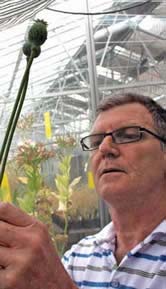Out of a dozen transgenic plants in Philip Larkin's greenhouse at Black Mountain Laboratory in Canberra, only two show any signs of life. These bulbous, green flower buds are all that remain of a productive line of research. The other plants are withered and yellow like corn stalks, crackling to the touch. "They look pretty cruddy, don't they?" Larkin says, during an overcast November day. "I'm obviously disappointed." Larkin, a plant geneticist at the Commonwealth Scientific and Industrial Research Organization, hasn't called it quits yet. If these poppies don't end up in your drug store, they may well end up in your gas tank. Poppy Power
almost a century old
It's a little known fact that since the 1950s, the island of Tasmania has supplied as much as 40% of the world's medicinal morphine. A handful of Tasmanian companies are licensed to grow the opium poppy, Papaver somniferum; Tasmanian Alkaloids, a wholly owned subsidiary of Johnson & Johnson, is one of the oldest and largest. The company conducts all its own breeding, supplies its proprietary seeds, contracts its own growers, and even manages the harvest.
A scientist built a better poppy, then his sponsor pulled the plug. Just over 10 years ago, Tasmanian Alkaloids asked Larkin to build a better poppy. After applying a chemical mutagen and screening poppies in the 1990s, the company discovered the top1 mutation that caused poppies to accumulate thebaine, a morphine precursor used in OxyContin and other high-value painkillers. They used traditional selective breeding to capitalize on their discovery, but they wanted to see how far Larkin could take the poppies using a dose of modern molecular genetics.
Larkin developed a 17,000-gene microarray to parse out the genetics underlying Tasmanian Alkaloids' top1 poppy (Nature, 431:413–4, 2004). Building on that study, he designed plants that overexpress the enzymes codeinone reductase or salutaridinol acetyltransferase, which could increase alkaloid concentrations by as much as 40%. Most recently, he's used RNA interference to get poppies to express novel chemical products, including reticuline and salutaridine, which have promising antibacterial, anticancer, and antimalarial properties (Nat Biotechnol, 22:1559–66, 2004; Plant Biotechnol J, 6:22–30, 2008). "Best fun I ever had in my life," he says. "We did practically everything we set out to do." Then, Tasmanian Alkaloids pulled the plug.
Company spokesman Rick Rockliff says that he was not happy with the decision either, but the Tasmanian government has some of the world's strictest policies on genetically modified organisms. The federal government continues to license technologies for everything from insect-resistant cotton to carnations with improved lifespans, but individual states deny their release. Instead of lobbying for changes, the company decided to put the project on hold, and Larkin let his poppies wilt. "We're waiting on the sidelines," Rockliff says.
In the next few months, Larkin's techniques may get another chance to prove their usefulness – as a biofuel. Geologist Eric Frost, founder of San Diego State University's Homeland Security program, and his colleagues were brainstorming ways to transform Afghanistan's opium poppy economy into a legal enterprise, and they contacted Larkin for his input. "Is there something more useful we can do with the crop?" they asked him. They threw around a couple of ideas until Larkin happened to mention biodiesel.
It turns out that opium poppies are known for their oily seeds; their oil content ranks up with canola. Compared with the palm-based biodiesel now used in Europe, poppy oils would run better at cold temperatures, and poppy agriculture does not require destroying tropical forests. "It looked crazy," says Larkin, "but the further we thought about it, it was a really simple idea with a lot of pluses." In 2005, Tasmanian farmers had even experimented with running their tractors on poppy biodiesel. At first, Larkin predicts, small biodiesel plants could supply power to Afghanistan's numerous rural communities, but scientists could eventually increase the oleic oil content in the seeds through genetic modification to make them more valuable for export. "We haven't got a cent yet," he says, "but we've got a lot of interest."
Refs
and further readingHOME
Opium
Images
Opium War
Opium People
Indian Opium
Opium Timeline
Painkillers/brain
Just For Chemists
The Golden Route
Pain and Prohibition
Opium Advertisement
The Abolitionist Project
The Afghan Connection
Heroin: A Drug Fit For Heroes?
Confessions of an English Opium Eater
Opium Smoking and Paraphernalia: a bibliography
Vicodin: 'some of them actually think they deserve it'

